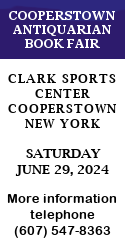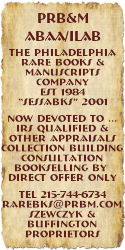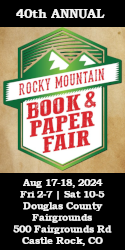How Chicago Lost One of America's Best Book Fairs: A Short history of Printers Row
It may seem self-serving and somewhat trite for a bookseller to lament the passing of Chicago's Printers Row Book Fair as an ideal outlet for the sale of used books, but in the broader sense of the bookseller's impact on society at large, the loss is significant in terms of public exposure and opportunities for spreading literacy, as should become apparent here. So what happened?
Printers Row is an open air marketplace of books that has taken place on a single early June weekend each year since 1985 in Chicago's downtown, along two blocks of Dearborn Street between the central public library on Congress and the old Dearborn Station on Polk. It was the brainchild of local resident and activist Barbara Lynne and the Near North Planning Board, a civic association trying to develop the South Loop as a tourist and residential attraction back when the area was a slum (according to Lynne) and a group of used booksellers was seeking a large venue to display and sell their books. The early book fairs attracted over 75 sellers of used and antiquarian books from around the metropolitan area, as well as bookbinders, calligraphers, papermakers and other book- and paper-arts related exhibitors who came not only for publicity but to expose the general public to the often unappreciated beauties of the book arts. There was even a vendor who sold antique printers' forms, letters and engravings that could be used as beautiful "rubber stamps," while experts calligraphers would offer hand-lettered cards or signs on any occasion for a modest price.
The fair grew in size and attendance for two decades under the excellent sponsorship of the Near North Planning Board and the City of Chicago's Department of Public Affairs, and drew support from various commercial ventures such as Target, Barnes & Noble, Jewel, and Columbia College Chicago. By 2003 it was claiming over 150 used and rare booksellers, several from out of state, and was also attracting authors for readings and special events. C-SPAN Book TV rented space for its mobile TV station. Attendance averaged over 90,000 for the two-day event, and the million visitor mark was passed in 2002, according to the Chicago Tribune. In short, it became one of the best and largest book fairs in the world, and inspired imitations in New York and Los Angeles. It was truly a "world-class event," according to founding exhibitor, Near North Board member and Powell's Books manager Brad Jonas in a 2004 interview.
In 2003 the Near North Board approached the Chicago Tribune and sold them the sponsorship of the fair. Immediate changes took place, most visibly the replacement of the multi-colored tents with sleek conical white tarps featuring the Tribune logo in blue on every side, with uniform blue table coverings. Not surprisingly, the table rents went up to pay for these as well as for promotional efforts, including a special section on the fair in the Tribune, posters and name tags with the Tribune logos, a new literary journal and blogsite called Printers Row, and media advertising on the Tribune's WGN TV and radio venues. Perhaps most significantly the biggest change was in the name, from Printers Row Book Fair to Chicago Tribune Printers Row LitFest. All this was in keeping with a highly laudable objective – that of nourishing and promoting new writers in need of a venue to publicize their work.
A newly expanded LitFest for authors, publishers and booksellers was welcomed by most, perhaps all exhibitors, until momentous changes in the reading and purchasing habits of the public began to take a toll on Tribune revenue and prices began to climb. (last year Tribune revenue fell 5.5 percent, with circulation and digital gains unable to offset advertising declines in the print edition – see the online report . It is not clear how much the loss of revenue, the higher costs of the fair, and the impact of the internet on print sales influenced the Tribune to begin a movement away from the promotion of used books and toward new books. University publishers, remainder houses, and even Borders and Barnes & Noble were given tent space and events featuring culinary arts and other non-book themes, including charity promotions proliferated (Open Books, a nonprofit literacy organization, was given a whole tent).
These certainly added to the cost of the fair, and prices for tables continued to rise, reaching $1,000 for two tent tables by 2014 and effectively driving out dozens of small used booksellers who worked on margins too narrow to absorb such an increase (the danger of inclement weather preventing the open display of higher-priced books). Whereas as late as the 2004 Tribune Printers Row section we counted 72 booksellers offering used, antiquarian and rare books along with periodicals and ephemera, by 2015 there were only 16 to be found in that year's Printers Row section.
The situation was not helped when the Tribune, without consulting the antiquarian booksellers association, decided to move this year's Printers Row LitFest from its traditional first weekend in June to June 11 and 12, the same weekend as the antiquarian book fair, thus forcing booksellers (including potential new exhibitors) to choose between the two events. There were outcries and suggestions from one Galena bookseller and this writer that the antiquarian booksellers launch a petition asking the Tribune to change back the dates and to make special provisions for smaller sellers in their tent prices, but according to the antiquarian booksellers association, only eight association members have participated in the LitFest for the past few years, so a petition was seen as pointless.
The results have been remarkable and, to some, sad. "I used to come to Printers Row in search of those beautiful Heritage Press slipcased classics," one longtime visitor told this writer. "Now there is only one bookseller who still carries them" (note: that bookseller is also this writer, and he won't be at the 2016 LitFest because he had already committed to exhibiting at the antiquarian book fair held by his professional booksellers' association.)
Among the many happy memories this writer cherishes of past Printers Row book fairs when used books were plentiful are the following:
The time a young Agatha Christie enthusiast discovered a rare Christie first edition, only to express her disappointment and dismay when she saw its price, although it was only $50 – low for a Christie first edition. On seeing this, the bookseller promptly cut the price in half. She reacted with so much joy – showing the book to her friends, thanking the bookseller profusely and happily taking possession at a price she could afford. The bookseller later remarked: "It was worth it to lower the price, to see that look on her face. Besides, think of how many books she is going to buy in the future."
Last summer a woman bought a copy of The Turn of the Screw. When the bookseller's assistant told her she liked the book, she said that her theater company, Chicago Fringe Theater, would soon be staging a production of it in a North Side mansion, so she was thrilled to find a nice old copy of it.
Another time Jim Blair, a retired high school teacher from Chicago's Sullivan and Wells High Schools, began to attend the fair regularly and discovered a retirement hobby in book collecting when the books he found there proved to so affordable, varied and plentiful that he said his literary interests were never neglected.
Another teacher walked the length of the fair each year, gathering books in a luggage carrier to supplement a small but growing stock that he hoped to use in his internet bookselling business, in order to supplement his inadequate teaching salary that supported his two young daughters.
It remains to be seen whether, in light of such individual cases and how representative they might be of the Printers Row Book fair experience, the public will help change the Tribune's current movement away from used books for Printers Row, or whether the latter's money woes will force it to give the Fair back to the Near North Planning Board (if the Board is still willing to take it back); or finally, if the city of Chicago will support a venue for the city's many dealers in used and antiquarian books, and allow them to bring back the experience and excitement of their onetime world-class book fair.
Carlos Martinez is an antiquarian and rare bookseller with a by-appointment shop on Chicago’s Southwest Side (Bibliodisia Books). He is one of the original sellers on Alibris/Interloc, and a member of IOBA and the Midwest Antiquarian Booksellers Association, where he served on the executive board. He has previously written for Book Source Magazine, The Caxtonian, Literary Chicago, and Bookseller Monthly.

























